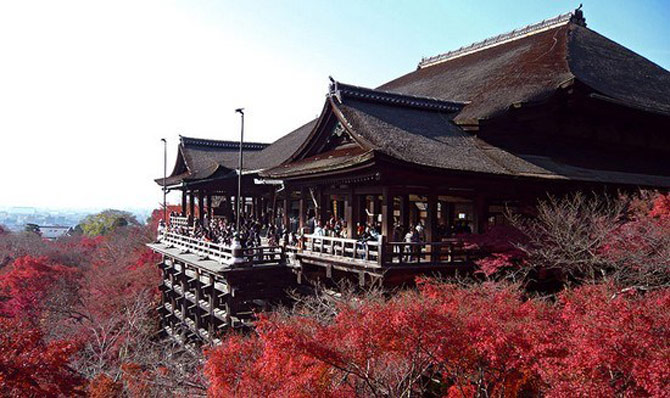Ancient Kyoto - World Cultural Heritage in Japan
Unesco's Scientific, Educational and Cultural Organization has recognized Kyoto as the World Cultural Heritage in 1994.
The ancient capital of Kyoto is the ancient city of Shiga Prefecture, the ancient capital of Kyoto is a complex of many Buddhist temples; Shinto shrine; Royal Castle .

As an ancient capital, Kyoto is the true ancient city until today. There are no skyscrapers, modern buildings here. In return, the ancient capital also preserved many historical and cultural relics both materially and spiritually (intangible). Kyoto is the embodiment of ancient, legendary Japan with a slow, peaceful, peaceful life. It is estimated that more than half of Japan's temples, shrines and ancient temples are concentrated in Kyoto. Low houses, hidden and intermingled fruit trees, narrow streets, many bicycles, few cars; humans are generous and have a characteristic of walking.

Kyoto is located on Japan's largest island Honshu - an area of nearly 228,000 km2. Both Tokyo, Osaka, Kobe, Hiroshima, Mount Fuji . are also on this island. In Kyoto there are 14 temples that Unesco has recognized as world cultural heritage. Kiyomizu (in Japanese means pure water) is one of the most beautiful temples in the world. Kiyomizu Temple was built in 778 on Otawa Hill, worshiping Quan Yin Buddha with thousands of hands . This oriental architectural masterpiece is mainly made of wood with 139 large, solid and solid columns. After the temple there is a waterfall flowing down the path into 3 lines, symbolizing human aspirations - that is love, health and money. Tourists come here to line up solemnly, holding dazzling streams of sacred water from the cliffs, drinking and praying. In the temple there is Jishu temple worshiping the God of Love, there are 2 small rocks placed about 18m apart.

Kinkaku-ji is also known as Rokuon-ji, Loc Uyen Pagoda, Vuon Nai Pagoda, Gac Vang Pagoda . built in 1397. Kinkaku is one of the unique pagoda architecture with 3-storey building. down to Kyoko-chi lake (also known as Kinh Tri). At first, only the walls of the 2nd and 3rd floors were covered with gold. The name of Gac Vang Pagoda has such origin. Currently, all 3-storey wall surfaces, both inside and outside, are covered in gold. In the beautiful autumn sunshine or full moon nights, shiny golden colors flowing down to the surface of the jade create a picture of the water wearing a mystery. Visiting the pagoda, the space is also filled with sacred and illusory gold. When on the light, Kinkaku stood out, glowing in the sky. The sophistication and sophisticated expression through the impressive position between the main yellow color of the pagoda, the pure green of the lake, the immense green color of the leaf tree, the green and blue of the sky, are charming to enchantment. . Kinkaku's landscape changes not only seasonally but also every month, every day; even every hour. Every moment has its own beauty, splendor, arrogance, quietness, discreetness .
Sanjusangendo - also known as Rengeo-in or 1,001 Buddha statue with thousand hands, built in 1164. Janjusangen do - means 33 spaces with hundreds of columns - 125m long, is considered the longest wooden building in the world. Look rustic, rustic but inside there are many surprises. The pagoda has 1,000 Buddha statues, of the same size as real people, with cypress wood, painted lipstick, styrofoam and gold inlay. Legend has it that each statue could save 1,000 sentient beings. Yasaka Temple has Japanese lanterns dense under the temple roof.
Yasaka is a Shinto Shinto shrine, built in 650, which usually hosts traditional Japanese weddings. The temple is located in Gion neighborhood, which is also the place chosen to host Japan's biggest festivals such as Gion or Hamo festival in July, all of which are from 869.
In addition, there are many other monuments in the ancient capital of Kyoto: Kamo Shrine; To Pagoda; Daigo Temple; Ninna Temple; Byodo monastery; Ujigami Temple; Kozan Temple; Saiho Temple; Ryoan Temple; Nijo Castle .







- Cultural landscape of Bam - World Cultural Heritage in Iran
- Himeji Castle - World Cultural Heritage in Japan
- Ancient villages of Shirakawa-go and Gokayama
- Secrets - World Cultural Heritage in China
- Acre ancient citadel - World cultural heritage in Israel
- Kaesong Ancient City - World Cultural Heritage in Korea
- Butrint - World cultural heritage in Albania
- Pasargadae - World Cultural Heritage in Iran
- Hwaseong ancient citadel in Suwon
- Citadel and tomb Cao Cu Ly - Cultural heritage of China
- Di Hoa Vien - World Cultural Heritage in China
- Hoang De and Hoanh Thon villages in Anhui
 Suzhou classic bonsai garden - China
Suzhou classic bonsai garden - China Chau Nguyen Dynasty
Chau Nguyen Dynasty Thai Son Mountain - World Wonder
Thai Son Mountain - World Wonder Ancient villages of Shirakawa-go and Gokayama
Ancient villages of Shirakawa-go and Gokayama